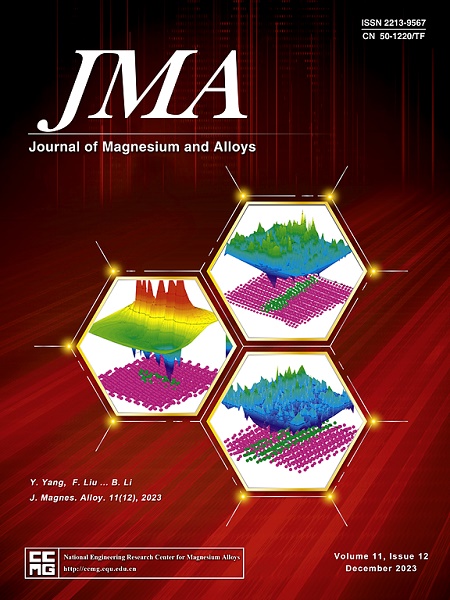通过挤压速度优化双峰组织,提高纳米tic /AZ61复合材料的塑性和韧性
IF 15.8
1区 材料科学
Q1 METALLURGY & METALLURGICAL ENGINEERING
引用次数: 0
摘要
本研究通过调节挤压速度,获得了具有不同异质双峰晶粒(HBG)结构和均匀结构的纳米 TiC/AZ61 复合材料。研究了 HBG 结构对复合材料机械性能的影响。仔细讨论了 HBG 镁基复合材料延展性和增韧机理。当挤压速度从 0.75 mm/s 增加到 2.5 mm/s 或 3.5 mm/s 时,微观结构从均匀结构转变为 HBG 结构。与均匀-0.75 mm/s复合材料相比,异质-3.5 mm/s复合材料在塑性变形阶段的延展性提高了116.7%,极限拉伸强度几乎没有降低。这主要是因为塑性变形的不均匀性较低,异质变形诱导硬化(HDI)导致的应变硬化较高。此外,与均匀-0.75 mm/s复合材料相比,Heterogeneous-3.5 mm/s复合材料的韧性提高了108.3%。这主要是因为粗晶粒(CG)带可以捕捉和钝化裂纹,从而增加裂纹扩展的能量消耗,提高韧性。此外,异质-3.5 mm/s复合材料的CG带具有较大的晶粒尺寸和较低的位错密度,更有利于获得较高的应变硬化和卓越的钝化裂纹能力。因此,与异质-2.5 mm/s复合材料相比,异质-3.5 mm/s复合材料延展性和韧性的提高更为显著。本文章由计算机程序翻译,如有差异,请以英文原文为准。
Improving the ductility and toughness of nano-TiC/AZ61 composite by optimizing bimodal grain microstructure via extrusion speed
In this study, the nano-TiC/AZ61 composites with different heterogeneous bimodal grain (HBG) structures and uniform structure are obtained by regulating the extrusion speed. The effect of HBG structure on the mechanical properties of the composites is investigated. The increasing ductility and toughening mechanism of HBG magnesium matrix composites are carefully discussed. When the extrusion speed increases from 0.75 mm/s to 2.5 mm/s or 3.5 mm/s, the microstructure transforms from uniform to HBG structure. Compared with Uniform-0.75 mm/s composite, Heterogeneous-3.5 mm/s composite achieves a 116.7% increase in ductility in the plastic deformation stage and almost no reduction in ultimate tensile strength. This is mainly because the lower plastic deformation inhomogeneity and higher strain hardening due to hetero-deformation induced (HDI) hardening. Moreover, Heterogeneous-3.5 mm/s composite achieves a 108.3% increase in toughness compared with the Uniform-0.75 mm/s composite. It is mainly because coarse grain (CG) bands can capture and blunt cracks, thereby increasing the energy dissipation for crack propagation and improving toughness. In addition, the CG band of the Heterogeneous-3.5 mm/s composite with larger grain size and lower dislocation density is more conducive to obtaining higher strain hardening and superior blunting crack capability. Thus, the increased ductility and toughness of the Heterogeneous-3.5 mm/s composite is more significant than that Heterogeneous-2.5 mm/s composite.
求助全文
通过发布文献求助,成功后即可免费获取论文全文。
去求助
来源期刊

Journal of Magnesium and Alloys
Engineering-Mechanics of Materials
CiteScore
20.20
自引率
14.80%
发文量
52
审稿时长
59 days
期刊介绍:
The Journal of Magnesium and Alloys serves as a global platform for both theoretical and experimental studies in magnesium science and engineering. It welcomes submissions investigating various scientific and engineering factors impacting the metallurgy, processing, microstructure, properties, and applications of magnesium and alloys. The journal covers all aspects of magnesium and alloy research, including raw materials, alloy casting, extrusion and deformation, corrosion and surface treatment, joining and machining, simulation and modeling, microstructure evolution and mechanical properties, new alloy development, magnesium-based composites, bio-materials and energy materials, applications, and recycling.
 求助内容:
求助内容: 应助结果提醒方式:
应助结果提醒方式:


